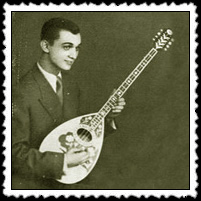 |  |
Radical Movement for Rebetiko Dechiotification
and Bouzouki Detetrachordization
The Radical Movement for Rebetiko Dechiotification and Bouzouki Detetrachordization claims for unity against :
| |
The Radical Movement for Rebetiko Dechiotification and Bouzouki Detetrachordization unilaterally demands :
|
 FACTS FACTS | |
| |
 GUILT GUILT | |
| |
|
"Manolis Chiotis, the first and maybe unsurpassed bouzouki virtuoso, added a fourth string thus making the tuning identical to that of the first four strings of the guitar; this made easier the guitar-like accompaniment to the virtuoso performance. Furthermore, he introduced the electric bouzouki in order to increase the volume, since the rebetika songs were now performed in huge, luxurious ball-rooms and in front of large audience. The vast amount of recording productions affected and altered the old, authentic style and quality unavoidably started to decline. From 1960 onwards, commerce and easy profit debased rebetiko." (Dimitris Kourzakis - http://www.forthnet.gr/rebetiko/essay/rebetik9.htm) | |
 |  | |
1938 : when he used to play Rebetiko* |
1950s : after he dealt with the devil | |
Please note that the proud man fattened, subsided, exactly as the neck of the bouzouki. * some people sent a mail to make us notice the 1938 Chiotis bouzouki is a tetrachordo. Nada ochi niet! As many of them, this is a real trichordo bouzouki with a 8 keys mechanics (probably adapted from a mandolin) using only 6 of them. Look at the rosette, there are only 3 (pairs of) strings. | ||
 AN EVIL BOUZOUKI FOR SOAP REBETIKO ? AN EVIL BOUZOUKI FOR SOAP REBETIKO ? | |
Chiotis' crime has been surpassed in 1984 with a MIDI bouzouki : | |
| "The MIDIBUZ incorporates the traditional features of a classic eight string bouzouki, yet offers the versatility and endless combinations found in a synthesizer." (Chris Hatzoudis and Dino Bersis - http://www.diodinos.com/history_midibouz.htm) | |
More, some italian luthier builds tetrachordo baglamas now !! | |
| What is going to happen now ? techno rebetiko ? double neck bouzouki ? Multiplex teke shows ? | |
 WHO ARE WE ? WHO ARE WE ? | |
We are : | |
| |
| Want to take a look to me playing outi with my friend hippo? Click on this thumbnail (the pic displayed is 242 Ko) Or a narcissic picture of me at the baglamas (80ko)? |  |
 ACTIVISM ACTIVISM | |
| We have two goals : Dechiotification and Detetrachordization. Our action means are very simple : | |
|

 USEFUL LINKS USEFUL LINKS | ||
| Fiskars | www.fiskars.com/ | |
| Leatherman | www.leatherman.com/ | |
| e-lawyers | ||
 DON'T MISS DON'T MISS | ||
| The Institute of Rebetology | (the famous Ed Emery's Rebetika Website) organizing the | |
| 4th International Rebetiko Conference (Hydra, 13-17 October 2004) | ||
 HOW TO JOIN US ? HOW TO JOIN US ? | |
| Free Life membership | send a splinter of a CD by Chiotis or a wreckage of tetrachordo bouzouki, or even a photograph of those items certified by authorities. |
 SEND YOUR COMMENTS ! SEND YOUR COMMENTS ! | |
 | |

